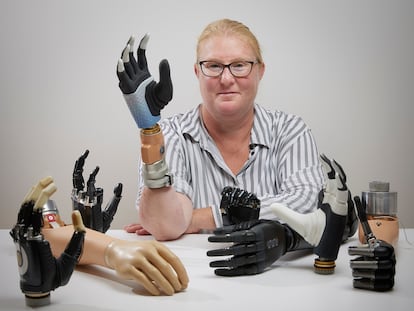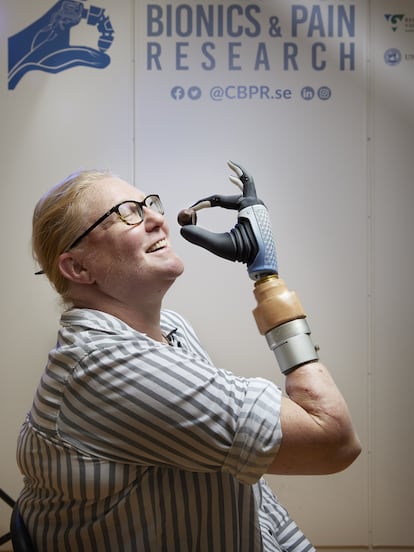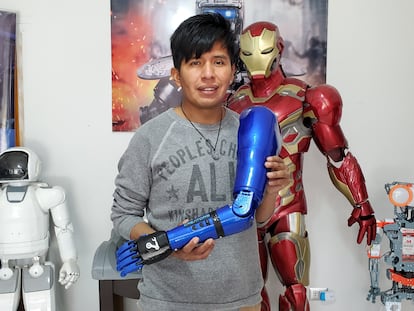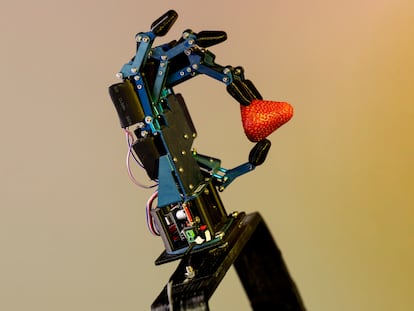Three years of living with a bionic hand: ‘This research has given me a better life’
A prosthesis with implanted electrodes has allowed a Swedish woman – who suffered an amputation after an accident – to regain sensation in her hand

Karin is a 50-year-old Swedish woman who, more than 20 years ago, suffered a farming accident that caused her to lose her right hand. A few years later, she participated in a study, which eventually resulted in her having a bionic hand implanted. She’s now had it for more than three years.
Thanks to the dexterity, reliability and functionality of the prosthesis — which is connected to her nervous and skeletal systems — her quality of life has improved. “It’s the only technology that currently allows a patient to use a prosthesis in daily life… it’s controlled by implanted electrodes and it allows for sensations,” explains Mexican professor Max Ortiz Catalán, author of the study published today in the journal Science Robotics. Ortiz is also head of neural prosthesis research at the Australian Bionics Institute and founder of the Center for Bionics and Pain Research (CBPR) in Sweden.
Since Karin (the research investigation doesn’t provide her last name) suffered the accident, she has suffered from unbearable pain in her phantom limb. ”I felt as if I constantly had my hand in a meat grinder, which created a high level of stress. I was taking high doses of various pain relievers,” she notes, in the press release that accompanies the publication of the study. Furthermore, conventional prostheses seemed uncomfortable, unreliable and of little help in daily life. “For me, this research has meant a lot, as it has given me a better life,” she affirms. Today, she has more control over the prosthesis, less pain and requires “much less medication.”
Karin uses the prosthesis at work, to take care of her garden, ride her bicycle and drive her car. It can be used for most everyday activities, such as setting the table, preparing dinner, or folding laundry, according to Jan Bzinden, author of the study and professor at Chalmers University of Technology in Gothenburg, Sweden. However, the electronic parts of the prosthesis aren’t waterproof, so if the patient wants to swim, she must first remove the prosthesis and put caps on the threaded implants, so as to protect the connectors. Dr. Ortiz adds that the bionic hand also isn’t useful for giving a massage.
In Spain, there are approximately 60,000 amputees, according to data from the Spanish Federation of Prosthetic Orthotists (FEDOP). To wear this type of bionic prosthesis, you have to meet certain requirements: you must be over 17-years-old and under the age of 70, while having enough bone mass to implant the titanium screw. Bzinden explains that you also mustn’t suffer from certain diseases or conditions that could affect the treatment.
The recently-published study evaluated the quality of life of people with the implant through a questionnaire, which posed queries about mobility, self-care, typical activities, pain or discomfort and anxiety or depression. It also evaluated the functionality of the bionic hand. The results ultimately showed that, with this particular kind of prosthesis, people’s disability and pain decreased, while problems typically associated with standard prostheses were reduced.
Karin underwent electromuscular surgery on her residual limb and received titanium implants in the ulna and radius bones of her forearm. The new bionic technology is characterized by the skeletal fixation of the prosthesis through osseointegration — the process by which “the bone tissue embraces the titanium, creating a strong mechanical connection,” as stated in the press release. Bzinden explains the process: “Two titanium screws are placed [in the patient], one in each bone of the forearm. The bone grows firmly over these screws, creating a stable and reliable connection point for the prosthesis.”
Using the screws helps patients avoid “the uncomfortable and often painful experience of wearing a socket,” Bzinden emphasizes. Sockets are the devices used by standard prostheses available on the market, to fix the prosthesis to the residual limb. “With the operation, the intensity of the pain in the phantom limb was reduced from [a level of] 5 to 3, while the pain in the stump completely disappeared,” Ortiz writes in the press release.

The neuromusculoskeletal implant allows the user’s nervous system to be connected to the electronic control system that’s incorporated into the prosthesis. “Our integrated surgical and engineering approach also explains the reduction in pain, since Karin now uses — in a way — the same neural resources to control the prosthesis that she once used for her missing biological hand,” Ortiz says.
Electrodes were also implanted in the patient’s muscles and around the nerves, which are used to elicit sensations in the absent hand. These are activated by sensors built into the prosthesis, according to the study. “When the patient tries to close the hand, this command goes down from the brain to the stump, where it’s captured by the electrodes that were implanted in the nerves and muscles, [thus closing] the robotic hand,” Ortiz explains
After using the system at home during the first year, Karin demonstrated greater myoelectric control capacity — that is, greater control over limb movement. Today, she continues to use the bionic hand.
Sign up for our weekly newsletter to get more English-language news coverage from EL PAÍS USA Edition
Tu suscripción se está usando en otro dispositivo
¿Quieres añadir otro usuario a tu suscripción?
Si continúas leyendo en este dispositivo, no se podrá leer en el otro.
FlechaTu suscripción se está usando en otro dispositivo y solo puedes acceder a EL PAÍS desde un dispositivo a la vez.
Si quieres compartir tu cuenta, cambia tu suscripción a la modalidad Premium, así podrás añadir otro usuario. Cada uno accederá con su propia cuenta de email, lo que os permitirá personalizar vuestra experiencia en EL PAÍS.
¿Tienes una suscripción de empresa? Accede aquí para contratar más cuentas.
En el caso de no saber quién está usando tu cuenta, te recomendamos cambiar tu contraseña aquí.
Si decides continuar compartiendo tu cuenta, este mensaje se mostrará en tu dispositivo y en el de la otra persona que está usando tu cuenta de forma indefinida, afectando a tu experiencia de lectura. Puedes consultar aquí los términos y condiciones de la suscripción digital.
More information
Últimas noticias
Most viewed
- Christian Louboutin: ‘Young people don’t want to be like their parents. And if their parents wear sneakers, they’re going to look for something else’
- ‘El Limones’ and the growing union disguise of Mexican organized crime
- Cartels in Mexico take a leap forward with narco-drones: ‘It is criminal groups that are leading the innovation race’
- The low-cost creative revolution: How technology is making art accessible to everyone
- ‘We are dying’: Cuba sinks into a health crisis amid medicine shortages and misdiagnosis











































